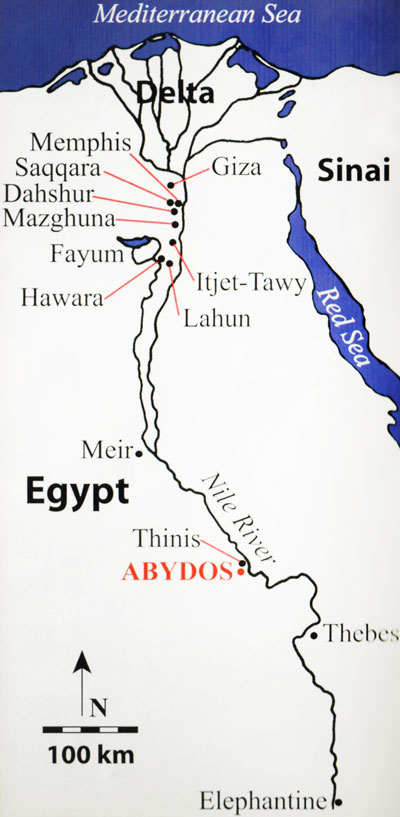Ancient Abydos (Abdju) played a lengthy and important role in the development of Egyptian civilization. Located 500 km south of Cairo, it sits on the desert’s edge, 15 km west of the Nile. During the Predynastic period (before ca. 3000 BCE) Abydos served as the cemetery site for a series of regional rulers whose capital, Thinis, was located nearby on the banks of the Nile. This early cemetery, known today as Umm el-Gaab (“mother of pots” in Arabic), was the kernel from which the subsequent importance of Abydos grew. In the Early Dynastic Period (ca. 3000–2700 BCE) the pharaohs of Egypt’s 1st Dynasty and two from its 2nd Dynasty built their tombs there. This royal necropolis was protected by a canine god named Khentiamentiu (“Foremost-of-the-westerners”), and though the temple dedicated to him is now largely destroyed, we do know its site, Kom es-Sultan.

The political importance of Thinis and Abydos diminished after Memphis (Egypt’s new capital just south of modern Cairo) was founded around 3000 BCE. With subsequent pharaohs being buried primarily in the Memphite necropolis, the significance of Abydos became understood increasingly in religious terms. By the end of the Old Kingdom (ca. 2200 BCE), Abydos had emerged as a primary cult center for Osiris, the god of the dead (on previous page). This deity, representing the incarnation of the deceased and reborn pharaoh as ruler of the netherworld, was now thought to have been buried at Umm el-Gaab. Joining this identity to that of the ancient canine god, Osiris-Khentiamentiu was now known as “Lord of Abydos.”
Veneration of Osiris continued to develop at Abydos during the First Intermediate Period (ca. 2200–2050 BCE) and the Middle Kingdom (ca. 2050–1700 BCE). Annual religious processions from Umm el-Gaab to the presumed burial place of Osiris expressed the belief that Osiris was buried at Abydos. Both the pharaohs and their subjects took increasing interest in the cult of Osiris. Royal cult buildings were erected in and around the main temple dedicated to Osiris in the Kom es-Sultan, while private chapels and tombs were built in the cemetery fields that extend west into the desert toward Umm el-Gaab.
Although the history of Abydos continued long after the end of the Middle Kingdom—indeed, the best-known monument from Abydos is the beautifully preserved 19th Dynasty temple built by Seti I (ca. 1294–1279 BCE)—the Middle Kingdom witnessed the classical development and florescence of the cult of Osiris. And during this period Senwosret III constructed his mortuary complex and tomb at South Abydos, expressing his intense personal devotion to Osiris-Khentiamentiu, Lord of Abydos.
